SLHS: Remarkable Rail Features 2:






Disclaimer
Whilst some care has been taken to check externally linked websites no responsibility is offered nor implied for the suitability, legality or reliability of content therein.
Statements are made here to the best of our knowledge. However no statement here should be regarded as irrefutable fact. Please contact us if you consider otherwise.
Hans von Kramer’s Railophone
We may think mobile phones are a recent invention. Think again. Taking up Marconi’s idea Hans Von Kramer had conducted his first experiments as far back as 1910 at Three Bridges in Sussex on the London, Brighton & South Coast Railway when he had succeeded in inducing an on-off signal between an express train and wiring connected to a signal box. Having established that signal transfer was possible he conducted more induction experiments at voice frequencies on the SMJ in 1911. This culminated in inauguration by Marie Corelli later that year. This is how the Rugby Advertiser* puts it:
-
“On Thursday last week, in the presence of a large company, Miss Marie Corelli opened the first “railophone” installation for wireless inductive telephony and signaling to and from moving trains, at the Stratford-on-Avon and Midland Junction railway station at Stratford.
-
The inventor is Mr Hans von Kramer, an Erdington electrical engineer, and by his system of wireless telephony he claims that it is now possible to send and receive messages of every description to and from any train, whatever the speed, or whether it is standing still in a station or along the line.
-
A distance of some 10 1/2 miles, from Stratford-on-Avon to Kineton, has been equipped with the system, which consists of two large frames of electric wires (one for receiving the other for sending messages) which are fixed round a railway coach. Alongside the line, a distance of several feet away, runs a wire – which may be underground or fixed on low posts – connecting up signal-boxes and stations. There is no mechanical contact between the wire and the train: the connection is “wireless,” the result of electro-magnetic induction emanating from the frame fixed on one of the coaches.”
Further Information..
-
BBC
-
History Of Broadcasting: Marconi's First Radio Broadcast Made 125 Years Ago
-
-
Our Warwickshire
-
*Copy Of Rugby Advertiser article: Wireless Messages from Trains in 1911-12
-
-
Warwickshire Railways
-
Full write-up: SMJ Railophone
Last update: 14/12/2024
● These items have aspects that uniquely contribute to national or world history.
Marconi with his Morse Code switch and wideband spark transmitter 1897 (Note Marie Corelli’s transmission was by voice)

-
● Full
-
● Partial
-
● None
-
Theatres ●
To return to Master page click on ‘Railways’ above.
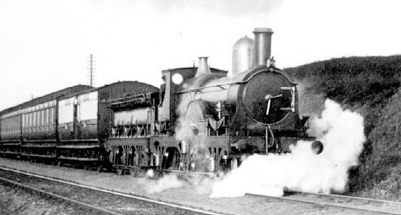
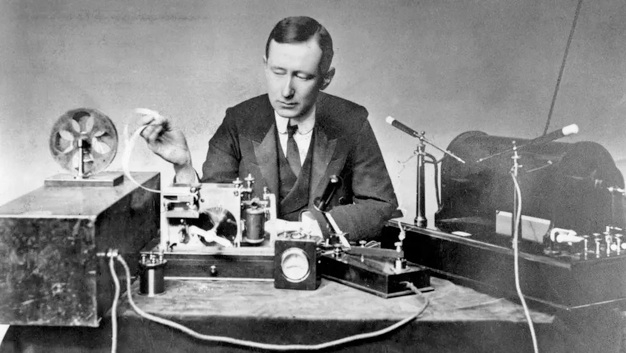
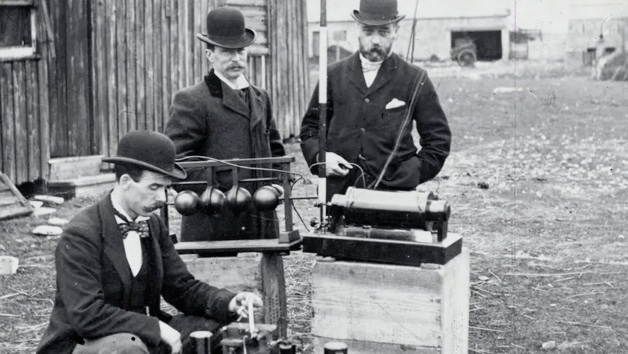
The Marconi wireless radio receiver being inspection by Post Office Engineers in Lavernock SWales
Miss Corelli’s Message
The author was in a marquee outside the station and sent the first message. It was received by the Mayor Alderman Deer in the coach on the moving train:
-
“I send hearty good wishes for the success of the railophone. I hope the railway companies will quickly adopt Mr von Kramer’s wonderful invention, which means complete safety for passengers and the more perfect control of railway traffic. I am very pleased to inaugurate what I believe will prove to be a great boon to the traveling world.”
His Worship made a reply, heard quite distinctly, so Miss Corelli informed the company.
● First Mobile Phone Call
Beginnings Of Radio
Guglielmo Marconi found that the Italians were not interested in his inventions so came to Britain who had a history of backing unusual inventions. Marconi was teamed up with Welshman George Kemp. After only a few months, on 13th May 1896 they managed to send a morse code message across the Bristol Channel.
Note The pictures below are not of the more sophisticated Railophone service.
Marie Corelli’s First Railophone Call
Background

Created: 12/12/2024
Locomotive Magazine and Railway Carriage and Wagon Review
In 1912 in Volume 1, Section 157, readers are told of a..
-
“Demonstration of wireless signaling on the Stratford & Midland Junction Ry.
-
A large party of signal engineers of British and Continental Railways met at the Stratford Station of the Stratford-on-Avon and Midland Junction Ry. on Friiday, 28 June, to attend a demonstration of the improved Railophone Wireless Inductive System of Telephoning, Telegraphing and Signaling. In the Locomotive Magazine for June, 1911, an account was given of the first installation of the Railophone system for the transmission of telephonic or telegraphic messages to or from trains in motion.
-
A far wider field for the application of this system is in the controlling of trains and safeguarding traffic. It is now possible to cause the ringing of bells, the sounding of whistles, the operation of the vacuum brake and stopping of trains without the intervention of the guard or driver. To do this by wireless methods, H. von Kramer and Gisbert Kapp have invented a highly sensitive detector, by which exceedingly feeble electrical impulses received on the train, from a vibrating charge sent into a ground wire alongside the track are picked up and relayed to sufficiently strong currents to ring a calling bell or hooter. The ringing up of a station from a moving train is thus effected.
-
The tests included the sending of messages from a moving train to Stratford Station and vice versa, the warning of a moving train by audible signal, signaling to a station from a moving train, the stopping of a train in motion by pressing a button in the signal box and the stopping of a train after it had been allowed to enter a particular section.
-
A final experiment illustrated the use of the Railophone system to prevent a "head on" collision on a single line which would have occurred by a signalman's mistake and only discovered too late to rectify under normal working. Both trains were automatically brought to a standstill, a collision being impossible with this system. Professor Silvanus P. Thompson presided at the luncheon which followed the demonstration.”
Ref: Steam Index
This was
See also the following patents: Improvements in resonating relays: 27063/1913 and 444/1914.

Von Kramer’s Successful System Was To Be Extended To Railway Safety
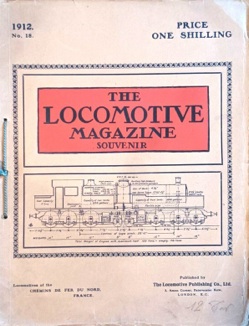
The robust railside safety apparatus in its final form in a signaling box
Demise
Although living in Birmingham Von Kramer was German. When war with Germany broke out in 1914 all support for his system was withdrawn due to the risks of sabotage or spying.
As some of you will know the GWR had also been developing a system of electronic safety on the railways but it didn’t have to be actively triggered. Their better, fail safe AWS† system, based upon permanent magnets de-energised by a green light cancellation coil, went on to be rolled out nationally given the impetus of some very serious rail accidents. Later still the Germans conducted their tests at Nurmberg and followed suit.
† See: Automatic Warning System
Von Kramer’s Funding Withdrawn Due To WW1
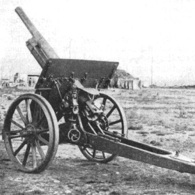
The guards van mounted apparatus which would apply the brakes by opening of the fail safe vacuum pipe.
Von Kramer’s Railophone
-
Others
-
Nature Magazine (download 400k):
-
Litarary Digest Magazine (download 400k):
US Patents
No312506 (download 340k): RailwayCarTelegraph_Patent312506_LuciusJPhelps1885.pdf
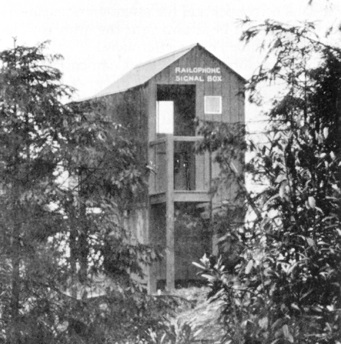
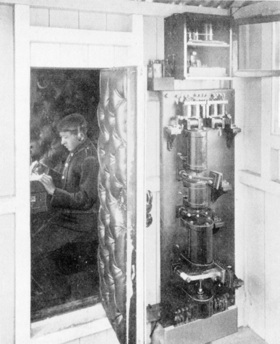
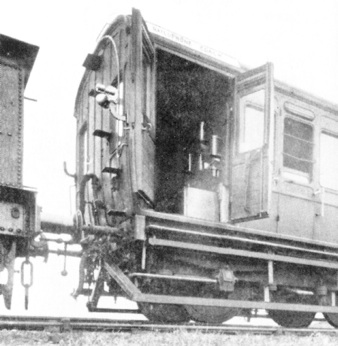


Railophone cable
Stratford Herald
Tests had been carried out on the SMJ at the Ettington signal box. The Stratford Herald were pleased to report:
-
“It is possible in the future that our borough will attain considerable importance in the eyes of the scientific world as the birthplace of a system which may play a prominent part in the railway kingdom, inasmuch as it claims to ensure safe traveling by rendering collision impossible, and repairing (also recording) mistakes made by careless signalmen. We refer to the Railophone double-automatic signaling apparatus.”
Shortly afterwards Von Kramer was answering questions when he accidentally leant on the train-stopping button bringing to an unexpected halt the trial train which was backing into the platform. Given the number of boffins bouncing about, and it seems such was the mood, that the Stratford Herald were unable to prevent themselves from poking fun at the finale:
-
“To end the day, the assembled visitors were conveyed by train to Clifford Siding where they alighted and climbed on to a bridge to witness 'possibly the most realistic tests of the day'. Two trains raced towards each other on the single line and use of the Railophone system averted a head-on collision. Perhaps this was not quite so exciting as it sounds because the Herald told its readers, 'A liberal margin was allowed for safety, and so there were no thrills'. “
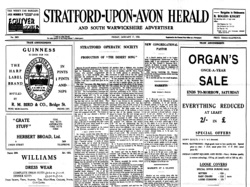
The Question Of Von Kramer
Delving into history a little more deeply one discovers that the British enthusiasm for this system was perhaps a little over played because it seems that Von Kramer was repeating what had already been discovered in the US. Whilst we perhaps have to give him some credit for the communication of the human voice using this system it transpires that it was not the first moving system of communications of a signal to a railway carriage.
That accolade may go, as far as we have ascertained, to Lucius J Phelps working for the US Telegraph in 1885. Patents of this age are not very readable, indeed there may be OCR mistakes in making an electronic copy of the document, but I leave you to decide whether Von Kramer was standing on the shoulders of a giant before him -see US Patent 312506 (below).
Final Word
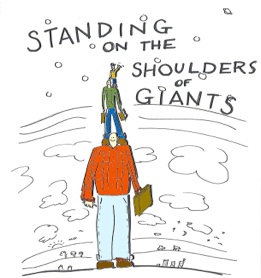
Addendum
By the way you may see this well used phrase of modesty plastered all over the internet and it being attributed to Isaac Newton. However even he was modest enough to insist that it was never he that coined it. Thus far it may be the Frenchman William of Conches (aka William Shelley) that coined it in 1123 (see Wikipedia).
Credit
In the same spirit we give credit to Jessica Witmer of Indiana for the monochrome version of the illustrative cartoon (right). See her other extremely beautiful and entertaining art works: ColourHive.com.
By The Way
